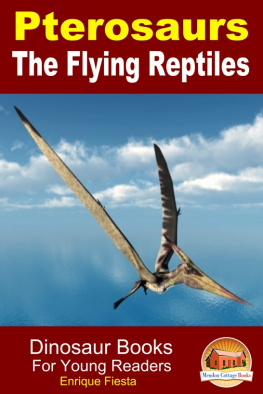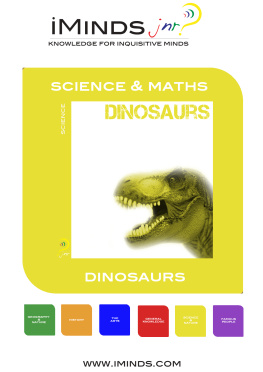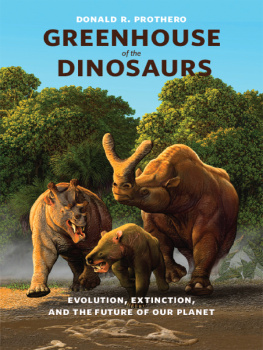
After the Dinosaurs
LIFE OF THE PAST
James O. Farlow, editor
After the Dinosaurs
The Age of Mammals
Donald R. Prothero
Indiana University Press
Bloomington and Indianapolis
This book is a publication of
Indiana University Press
601 North Morton Street
Bloomington, IN 47404-3797 USA
http://iupress.indiana.edu
Telephone orders 800-842-6796
Fax orders 812-855-7931
Orders by e-mail
2006 by Donald R. Prothero
All rights reserved
No part of this book may be reproduced or utilized in any form or by any means, electronic or mechanical, including photocopying and recording, or by any information storage and retrieval system, without permission in writing from the publisher. The Association of American University Presses Resolution on Permissions constitutes the only exception to this prohibition.
The paper used in this publication meets the minimum requirements of American National Standard for Information SciencesPermanence of Paper for Printed Library Materials, ANSI Z39.48-1984.
Manufactured in the United States of America
Library of Congress Cataloguing-in-Publication Data
Prothero, Donald R.
After the dinosaurs : the age of mammals / Donald R. Prothero.
p. cm.(Life of the past)
Includes bibliographical references and index.
ISBN 0-253-34733-5 (cloth : alk. paper) 1. Mammals, Fossil. 2. PaleontologyCenozoic. I. Title. II. Series.
QE881.P76 2006
569dc22
2005033287
1 2 3 4 5 11 10 09 08 07 06
This book is dedicated to my sons
Erik, Zachary, and Gabriel Prothero
May their Cenozoic future be bright
The opening of the next great period in the life of the earth, the Cainozoic period, was a period of upheaval and extreme volcanic activity. Now it was that the vast masses of the Alps and Himalayas and the mountain backbone of the Rockies and Andes were thrust up, and that the rude outlines of our present oceans and continents appeared. The map of the world begins to display a first dim resemblance to the map of to-day.
At the outset of the Cainozoic period the climate of the world was austere. It grew generally warmer until a fresh phase of great abundance was reached, after which conditions grew hard again and the earth passed into a series of extremely cold cycles, the Glacial Ages, from which apparently it is now slowly emerging.
H. G. Wells, A Short History of the World, 1922
CONTENTS
Preface
The Mesozoic Era, or Age of Dinosaurs, is enormously popular in the public eye, with numerous books and television shows documenting the fascinating lives and times of these tremendous creatures. But for the last 65 million years, the dinosaurs (except for their bird descendants) have been extinct. In their place evolved an enormous variety of land creatures, especially the mammals, which are equally bizarre and fascinating to the public and paleontologist alike. The Age of Mammals, or the Cenozoic Era, has not received nearly same amount of attention as the Mesozoic. Yet there is an amazing story of the rapid evolution of thousands of species of mammals, including gigantic hornless rhinos, sabertoothed cats, mastodonts and mammoths, and many other fascinating creatures (including our own ancestors). This story is part of a larger story of global climate change: from the greenhouse conditions of the Mesozoic, the world warmed up dramatically about 55 million years ago and then began to cool down, so that glacial ice returned by 33 million years ago. The vegetation of the world went through an equally fascinating transformation, from tropical jungles in Montana and forests at the poles to grasslands and savannas across the entire world by 7 million years ago. And life in the sea, although less familiar to us, also underwent dramatic changes reflecting global climate change, including the evolution of such creatures as giant great white sharks, seals, sea lions, and dolphins and whales.
Yet there are remarkably few accounts of the Cenozoic for the nonspecialist. The first synthesis was Henry Fairfield Osborns The Age of Mammals in Europe, Asia, and North America (1910), which represented what was known almost a century ago. Since then, a few books have focused on the evolution of Cenozoic mammals exclusively, such as Bjrn Kurtns The Age of Mammals (1971) and Jordi Agusti and Mauricio Antons Mammoths, Sabertooths, and Hominids: 65 Million Years of Mammalian Evolution in Europe (2002). Only Charles Pomerols The Cenozoic Era: Tertiary and Quaternary (1982) described not only mammals but also the climatic story and the evolution of marine life, but it is twenty-four years out of date and also out of print. Since that time, we have learned a tremendous amount about the dating and correlation of Cenozoic rocks, the changes in Cenozoic climate, and especially the evolution of Cenozoic life, from the plants and plankton to the mammals. This book attempts to bring all these new discoveries into a common context for the intelligent lay reader and the scientist who is not a specialist in Cenozoic geology and paleontology. I have attempted to write at a fairly general level, although some geological and biological concepts are assumed (or introduced in the first chapter). However, I have also tried to show the evidence for our conclusions about Cenozoic events and to provide full scientific references for those who wish to go on to the primary literature. I hope that geologists, paleontologists, and general readers will find this book as useful for the twenty-first century as Osborns book was for the twentieth century.
Donald R. Prothero
La Crescenta, California
June 2005
Acknowledgments
A project such as this would not have been possible without the aid of many people. I thank Jim Farlow for supporting the project, and Bill Berggren and Jim Farlow for reading the manuscript carefully and correcting many errors. I thank Bob Sloan, Miki Bird, Jane Quinet, and Kevin Marsh at Indiana University Press for their editorial help, and Carlotta Shearson for careful copy editing. I thank Mark Hallett for the striking cover art and for providing other images. Numerous colleagues sent me photographs and illustrations, and they are acknowledged in the appropriate places. I thank the national Science Foundation and the Petroleum Research Fund of the American Chemical Society for their financial support, which makes this research possible. Most important of all, I thank my amazing wife, Teresa, and my sons, Erik, Zachary, and Gabriel, for their love and support. They have made all the blood, sweat, and tears of producing this book worthwhile.
After the Dinosaurs

Figure 1.1. Reconstruction of late Eocene brontotheres. Painting by Z. Burian.
Introduction
Fossil hunting is by far the most fascinating of all sports. It has some danger, enough to give it zest and probably about as much as in the average modern engineered big-game hunt, and the danger is wholly to the hunter. It has uncertainty and excitement and all the thrills of gambling with none of its vicious features. The hunter never knows what his bag may be, perhaps nothing, perhaps a creature never before seen by human eyes. It requires knowledge, skill, and some degree of hardihood. And its results are so much more important, more worthwhile, and more enduring that those of any other sport! The fossil hunter does not kill, he resurrects. And the result of this sport is to add to the sum of human pleasure and to the treasure of human knowledge.
Next page




















